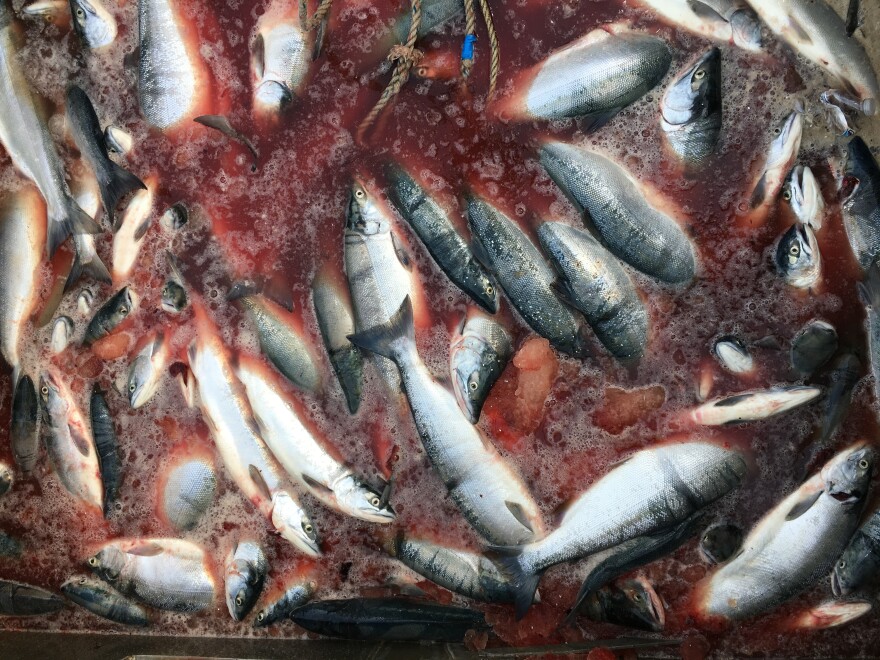Many Bristol Bay salmon processors give bonuses to fishermen who can chill the fish sitting in their boat’s hold. That’s not so easy, though, when ice is in short supply.
Bristol Bay’s Nushagak fishing district pulled in more than a million sockeye on eight separate days earlier this month. Before this summer, it had only done that twice in Bristol Bay’s history.
Keeping all those fish cool proved problematic for fishermen who still rely on slush ice. Capt. Nick Sotiropoulos of the fishing vessel Flyin’ Tiger said he’d like at least 1,000 pounds of ice for every opener to keep his catch cold and earn that chilled quality bonus from his processor.

"A couple of the busy days, the Bristol Maid, the ice barge was limiting to 500 pounds and there was a lot of fish being caught that day. That's enough ice to fill up a few holds, but we didn't really know what to do after that," Sotiropoulos said.
It wasn’t just the ice barge that struggled to keep up with demand. Tenders also couldn’t hack it.
"When (tenders) bring it out from town, they announce over the VHF that they've got bags of frozen water molecules, and it's a big race to see who can get the ice first," said deckhand J.R. Haukins of the F/V Baze. "Ice is a hot commodity out there, and I'm not sure everybody gets it as quick as they want it. It's a price deduction come delivery time."
Trident Seafoods and the Bristol Bay Economic Development Corporation team up to run the ice barge near Clark’s Point. Neither group would comment on how often they limited ice this summer. BBEDC president Norman Van Vactor said they had to prioritize ice for Bristol Bay residents over out-of-state fishermen.
"The issue here on the Nushagak this year was one of volume," Van Vactor said. "Thirty million fish on this river system here obviously is just off the charts, and so the demand for ice this year was also off the charts."
Van Vactor’s right when he said volume was up this year. On the traditional season peak of July 4, records from the Alaska Department of Fish and Game records show 674 boats were fishing Nushagak. That’s twice as many vessels as the district has averaged on Independence Day for the past four years (389 in 2017; 308 in 2016; 325 in 2015; and 335 in 2014).
Considering that, Sotiropoulos said he doesn't fault the ice barge for putting in limits.
"Everybody was doing the best that they could, but given the number of boats that were here, it was just kind of a mess trying to keep all the fish cold," Sotiropoulos said.

Fewer boats were fishing east-side districts as the run trickled in several days late, so Van Vactor said the Bristol Lady didn’t experience any ice shortages. That's the other barge BBEDC operates with Ocean Beauty Seafoods at the Y in Naknek.
Just over 10 percent of Bristol Bay’s fleet relies on ice to chill their fish. Another 27 percent turn over unchilled fish to processors, and the final 63 percent are drift boats with refrigerated sea water systems. Those figures come from a 2017 Northern Economics study for the Bristol Bay Regional Seafood Development Association.
Van Vactor said the BBEDC and its processor partners will discuss how to prevent ice shortages for next summer, but he’s also eying long-term change for the drift fleet.
"For folks that might have had ice problems, may this be the catalyst for them considering RSW systems and becoming more self-sustaining on their own as well," Van Vactor said.
He said he personally loves the quality of slush ice fish, but that RSW allows for much more efficient fishing. He realizes, though, that outfitting boats with RSW is a pricey endeavor. He promised that BBEDC would continue to help local fishermen get ice for the immediate future.
"A lot of the smaller, older fiberglass boats just are not that readily adaptable. They are going to need to be continually supported by either ourselves and access to ice from the ice barge or from their processor," Van Vactor said.
In the end, Van Vactor called Nushagak’s ice shortage a minor issue when compared to other parts of Alaska like the Chigniks, where even subsistence fishing is questionable this year. Sotiropoulos added that he feels confident enough of his fish were down to temperature to earn that chilled fish bonus from his processor.
Most processors still haven’t released 2018's prices, but Trident Seafoods paid fishermen an extra 25 cents per pound for chilled, floated and bled sockeye in 2017.





